Nagano
Nagano is the capital of its prefecture in a mountainous area of central Japan, which has become world famous after having hosted the Winter Olympics in 1998.
The main attractions are two sacred places, the Togakushi Shinto shrine and, above all, the Zenkoji Buddhist temple.
Zenkoji Temple
One of the most famous and most visited temples in all of Japan, the only real tourist attraction in the city center of Nagano.
This temple is famous for several reasons. This is the largest temple of the entire eastern Japan, dating back to ancient times (it was founded in the seventh century), and keeps a statue of Buddha which is claimed to be the oldest Buddhist statue of Japan, it is assumed it came from India passing through Korea, in the year 552. This statue has been guarded by the monks of the temple for hundreds of years and it is absolutely forbidden to show it to strangers, so no one has ever seen it. Every six years, a copy of the statue is shown to visitors during a special event. The last time this event was held was in 2015, and the next time is therefore planned in 2021.
To get to the temple you have to walk along a long street full of shops (
Nakamise), that begins immediately after the first entrance gate to the temple (
Niomon Gate) and ends in front of the
Sanmon Gate, dating back to 1750 and whose interior houses some valuable statues and can be visited (admission 500 yen). Shortly before the Sanmon gate, on the right, you can see a series of six different Buddha statues (
Roku Jizo),
The area within the temple grounds can be visited without paying any entrance fee, and there you can visit the main building, dating back to 1707.
You can also pay an entrance fee of 500 yen in order to enter in three particular areas:
-the
Naijin (内陣), an area with tatami (you must take off your shoes) next to the altar inside the main building of the temple, the rest of the building is freely accessible;
-the
Okaidan Meguri (戒壇巡り), a truly curious area, which can be accessed going downstairs from the Naijin inside the main building; at the end of the stairs you find yourself in a completely dark place, and you can try to find a key, located in one of the walls of the corridor, which is the "key to enter heaven" Anyone who can find it and touch would ensure his own access to the Buddha's paradise;
-the
Pagoda Chureiden, behind the main building, which houses inside the
Zenkoji History Museum, with numerous religious statues on exhibition.
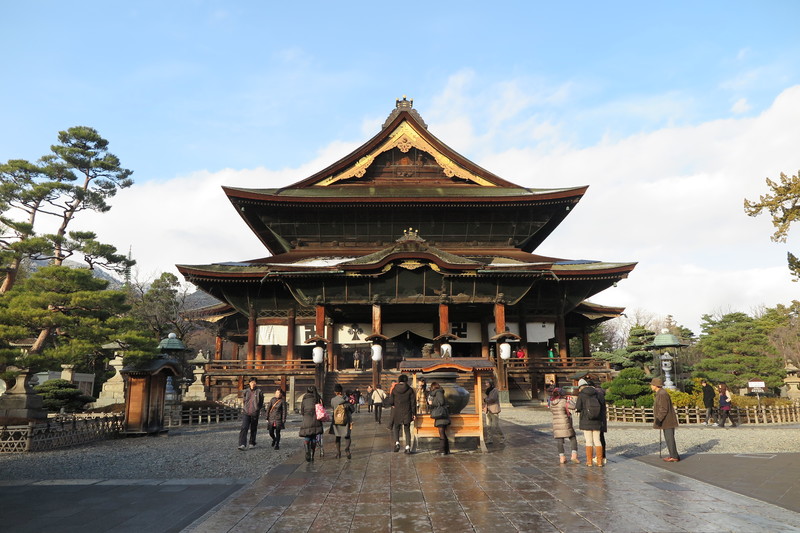 the main building of the Zenkoji Temple
the main building of the Zenkoji Temple
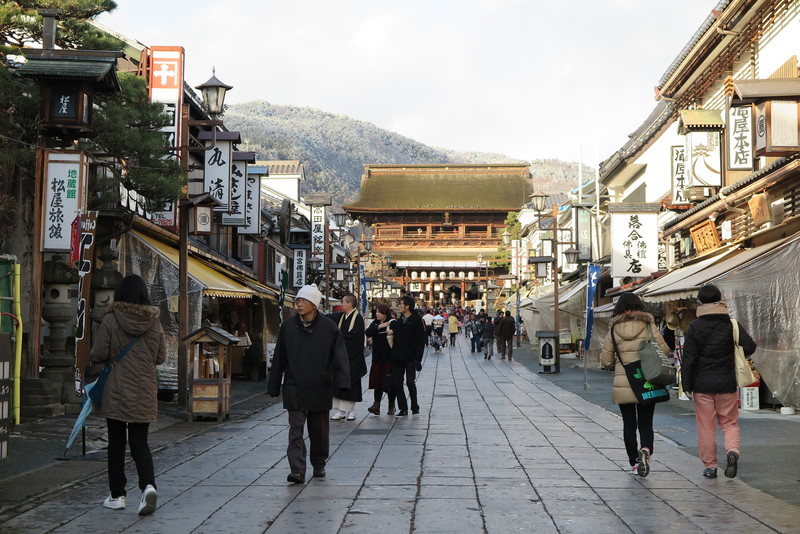
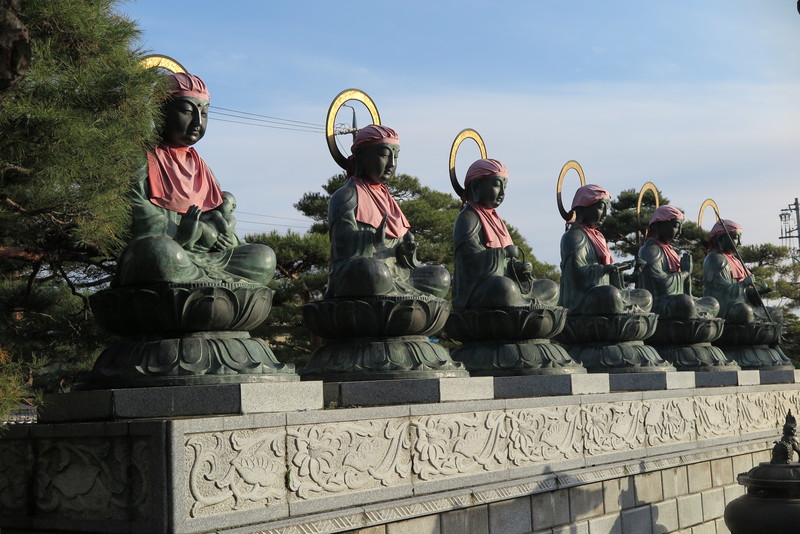 the access road to the Zenkoji Temple
the access road to the Zenkoji Temple
Shinano Art Museum
(variable admission fee, opening hours 9-17, closed on wednesdays)
An exhibition space for different exhibitions changing over the months, the calendar is available only in Japanese at
this link. It is a short walk from the Zenkoji temple, to the east.
Higashiyama Kaii Gallery
(admission 500 yen, opening hours 9-17, closed on wednesdays)
This art gallery is located right next to the Shinano Art Museum, and houses a large collection of paintings by the Japanese painter
Kaii Higashiyama.
Nagano 1998 Winter Olympics
From 7 to 22 February 1998 the city of Nagano hosted the eighteenth edition of the Winter Olympics.
Among the remaining buildings to the city from these Olympics, the most important are the
Olympic Stadium (currently a baseball field, it was used for the opening ceremony), the
White Ring (that was used for ice skating) and especially the building called
M-Wave.
M-Wave
The name of this building derives from its external form, which appears to have the shape of a "M".
During the Olympics it was used for speed skating events, and today is an ice skating rink open to the public during the winter, and it often hosts special events.
Inside the building there is also a store of gadgets and souvenirs (open everyday) and the
Nagano Olympics Exhibition Corner (free admission, 10-17, only on weekends and public holidays), a corner in memory of the memorable event involving the small town of Nagano, many photographs and objects related to the Olympics Games are on display here, including the original Olympic torch.
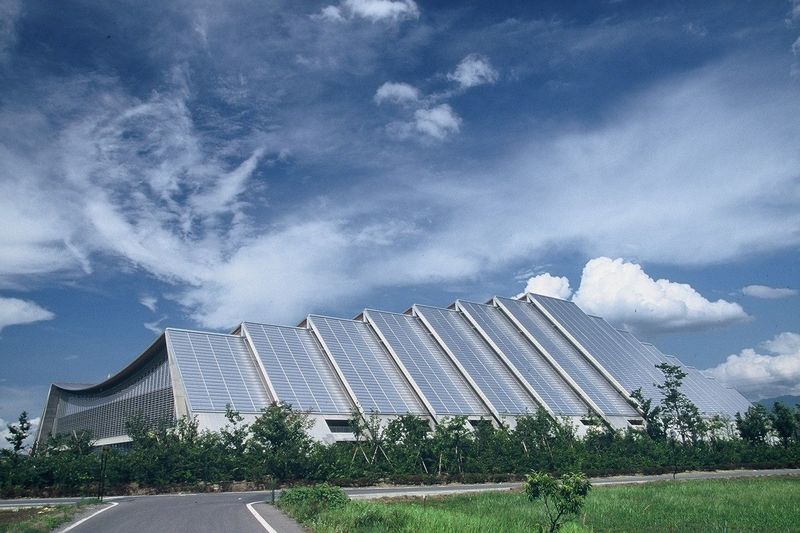 the facade of the M-Wave
the facade of the M-Wave
Togakushi Shrine
The term Togakushi Shrine refers to a complex of Shinto shrines scattered in the forest at the foot of Mount Togakushi, within the
Jōshin'etsu-kōgen National Park. The area is about one hour by bus from Nagano Station.
There are a total of five Shinto shrines, in three separate areas around 2 kilometers away from each other, connected by paths and stairs that go through the forest, in a very charming atmosphere, especially on the way to the highest shrine, called
Okusha.
In the maps you will find the three areas named as "lower shrine", "middle shrine" and "upper shrine". The area around the "middle shrine", It is an area full of restaurants, shops and ryokan.
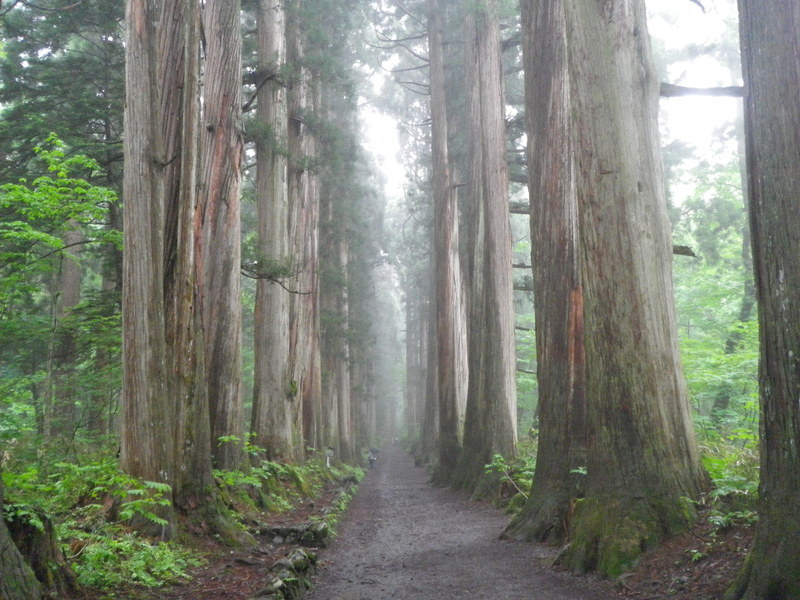 fascinating path shortly before arriving at the highest shrine
fascinating path shortly before arriving at the highest shrine
Togakushi Minzoku-kan
(admission 500 yen, opening hours 9-17, closed from mid-November to mid-April)
Literally "Folklore Museum of Togakushi", this museum is located near one of the three Shinto shrines of the mountain, the higher one, and is divided into two separate buildings.
A first building dedicated to the daily lives of people during the Edo period, with many objects and instruments.
A second building, called
Togakure Ninpo Museum, is dedicated to the ninja world, with original objects and weapons, and other small curiosities, but the main attraction for visitors at the end is always the "Ninja House", a building full of traps and secret passages where you have to be able to get out.
It is said that right in these mountains a famous school of ninjutsu, known as
Togakure Ryu Ninpo, was founded in the twelfth century.
Eating in Nagano
Oyaki
Oyaki are a typical street food in the city of Nagano, you can find them for sale anywhere in the streets of the city.
They are dumplings made with wheat flour and cooked on the grill, they can be filled with various things, usually vegetables such as eggplant, mushrooms or pumpkin. There is also a sweet version filled with sweet red bean paste (azuki).
Where to stay in Nagano, recommended accommodation
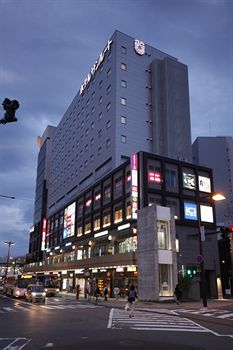 Hotel Sunroute Nagano
This hotel is located very close to Nagano station, the main station of the city served by shinkansen and several bus lines to the major attractions of the city. The hotel belongs to the reliable Japanese Sunroute hotel chain, which guarantees a high level of cleanliness and comfort and a good value. Single rooms on offer from ¥ 6,000 per night.
Hotel Sunroute Nagano
This hotel is located very close to Nagano station, the main station of the city served by shinkansen and several bus lines to the major attractions of the city. The hotel belongs to the reliable Japanese Sunroute hotel chain, which guarantees a high level of cleanliness and comfort and a good value. Single rooms on offer from ¥ 6,000 per night.
Shukubo in Nagano
The most special experience you can do in Nagano, popular among the Japanese but virtually unknown among foreign tourists, is to sleep in one of the many rooms inside the Zenkoji Temple, located along the streets parallel to the Nakamise. Booking these rooms, if you have no knowledge of the Japanese language and you do not have any friends who can help you is almost impossible, since reservations can be made only by telephone. More information in
this page in Japanese.
Until recently it was possible to book one of these rooms through booking.com, but now when I'm writing this page it's no longer available. However, I leave the link in the event it is reactivated in the future:
Shukubo Zenko-ji Temple Tokugyobo.
How to get to Nagano
From Tokyo
By train
The high-speed trains (shinkansen) called
Asama connect Tokyo (Tokyo station or Ueno) and Nagano in about 100 minutes, 8000 yen one way.
This is the only way to get to Nagano by train, via traditional lines the journey times are unacceptable (about 7 hours). If you haven't a
Japan Rail Pass and 8000 yen each way are too much for your budget, the only alternative is the bus.
By coach
Taking the bus is an undoubtedly slower solution (about 4 hours) but significantly cheaper to get to Nagano from Tokyo.
The company
Keio Bus offers 15 daily departures at the price of 4000 yen, 7200 yen round trip. More information
here.
The company
Willer Express offers 13 daily departures with prices starting at 1,500 yen one way sometimes. More information
here.
From Nagoya, from Osaka and Kyoto
By train
The limited express trains called
Shinano of JR connects Nagoya station and Nagano in about 3 hours for 7330 yen one way.
If you come from other major cities west of of Nagoya (for example Osaka or Kyoto), the fastest solution is to get to Nagoya (see
How to get to Nagoya), and once there take the Shinano limited express train.
By coach
The company
Meitetsu connects Nagoya and Nagano by bus in about 4 hours and a half with prices starting at 3600 yen.
There is no online purchase service in English, you can get information or buy tickets directly at the
Meitetsu Bus Center, located above the Meitetsu Nagoya station (a few meters south of the JR Nagoya station).
Map of Nagano
Guided tours, activities and other things to do
If you are planning a trip to Japan and you want to do something more than just visiting famous places and monuments, we suggest you to use
Rakuten Travel Experiences.
How to use Rakuten Travel Experiences
Rakuten Travel is a very useful website to
enrich your travel experience, especially if you are going solo or it's your first time in Japan.
Because of the language barrier (and more), in Japan it is very difficult to interact with the locals and to get off the tourist track.
Thanks to Rakuten Travel you can find a lot of interesting and sometimes unique
guided tours and activities all over Japan (and not only in Japan), that you would otherwise never be able to enjoy.
But there's more: on Rakuten Travel you can also
buy tickets for several famous attractions, events, transportation and other useful services for tourists. Last but not least, you can
reserve a table in hundreds of restaurants.
Some examples
Take a look at Rakuten Travel Experiences
You may also be interested in
 Hotel Sunroute Nagano
Hotel Sunroute Nagano